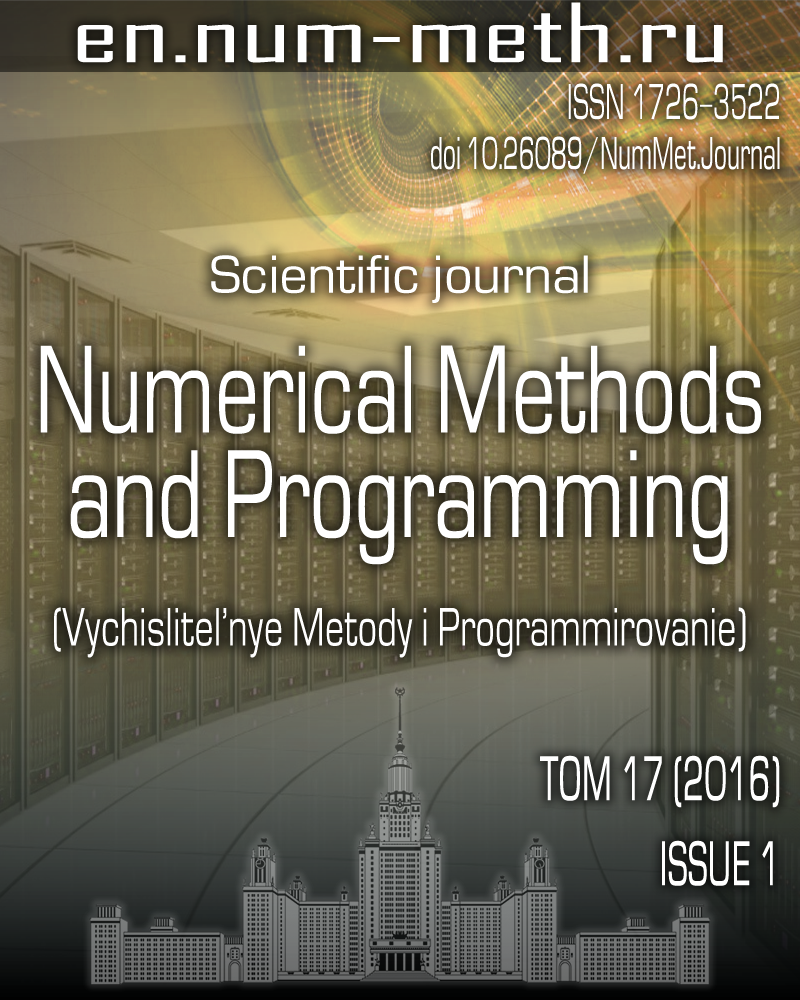Application of multiGPU+CPU architecture for the direct numerical simulation of laminar-turbulent transition
DOI:
https://doi.org/10.26089/NumMet.v17r106Keywords:
multiGPU, hybrid GPU and CPU architecture, direct numerical simulation, laminar-turbulent transition, dynamical systems, high order numerical methodsAbstract
The use of various parallel computational architectures for the direct numerical simulation (DNS) of laminar-turbulent transition problems (LTTPs) is summarized. Usually, DNS results are analyzed on the basis of a set of statistical parameters: pulsation velocities correlations, energy spectra, etc. When a dynamical system analysis approach is applied to DNS results, it is necessary to evaluate additional parameters: eigenvalues of Jacobi matrices, phase space attractors, and eigenvalues of monodromy matrices, etc. This allows one to present results as bifurcation scenarios and diagrams and bring up more details concerning LTTP scenario as functions of bifurcation parameters (e.g., Reynolds, Mach, and Froude numbers). This problem is computationally expensive and algorithms are complex. This brings up more demands on the hardware efficiency and software algorithm optimization. We are using GPU and multiGPU together with CPU architectures since 2008 for this kind of DNS. We considered eight different LTTPs since then. Various high-order methods were applied. In this paper we show typical computational operations for each class of problem. We illustrate the application of libraries and algorithms, perform efficiency benchmarking across GPUs and with CPU versions. It is shown that in general one GPU is 5 to 35 times faster than CPU. The acceleration is worse than linear and is proportional to a power function with an exponent between 0.78 and 0.81. We use five GPUs for multiGPU and show CPU+multiGPU efficiency for one of the problems under consideration.
References
- E. F. Toro, Riemann Solvers and Numerical Methods for Fluid Dynamics (Springer, Berlin, 1999).
- I. E. Sarris, S. C. Kassinos, and D. Carati, “Large-Eddy Simulations of the Turbulent Hartmann Flow Close to the Transitional Regime,” Phys. Fluids 19 (2007).
doi 10.1063/1.2757710 - P. G. Frik, Turbulence: Approaches and Models (Inst. Komp’yut. Issled., Moscow; Izhevsk, 2003) [in Russian].
- D. A. Silaev and D. O. Korotaev, “Solving of Boundary Tasks by Using S-Spline,” Komp. Issled. Model. 1 (2), 161-171.
- CUFFT 1.1 / 2.0 vs FFTW 3.1.2 (x86_64) vs FFTW 3.2 (Cell) comparison.
"
http://www.sharcnet.ca/ merz/CUDA_benchFFT/" . Cited February 15, 2016. - N. M. Evstigneev and N. A. Magnitskii, “FSM Scenarios of Laminar-Turbulent Transition in Incompressible Fluids,” in Nonlinearity, Bifurcation and Chaos. Theory and Applications (InTech, Rijeka, 2012), pp. 250-280.
- N. M. Evstigneev, N. A. Magnitskii, and S. V. Sidorov, “A New Approach to the Explanation of the Nature of Turbulence in a Viscous Incompressible Fluid,” Tr. ISA RAN 33 (12), 49-65 (2008).
- N. M. Evstigneev, N. A. Magnitskii, and S. V. Sidorov, “On the Nature of Turbulence in a Problem on the Motion of a Fluid behind a Ledge,” Differ. Uravn. 45, (1), 69-73 (2009) [Differ. Equ. 45 (1), 68-72 (2009)].
- N. M. Evstigneev, N. A. Magnitskii, and S. V. Sidorov, “On the Nature of Turbulence in Rayleigh-Benard Convection,” Differ. Uravn. 45, (6), 890-893 (2009) [Differ. Equ. 45 (6), 909-912 (2009)].
- N. M. Evstigneev, “Numerical Integration of Poisson’s Equation Using a Graphics Processing Unit with CUDA-Technology,” Vychisl. Metody Programm. 10, 268-274 (2009).
- N. M. Evstigneev and N. A. Magnitskii, “On Possible Scenarios of the Transition to Turbulence in Rayleigh-Benard Convection,” Dokl. Akad. Nauk 433 (3), 318-322 (2010) [Dokl. Math. 82 (1), 659-662 (2010)].
- N. M. Evstigneev and N. A. Magnitskii, “Nonlinear Dynamics in the Initial-Boundary Value Problem on the Fluid Flow from a Ledge for the Hydrodynamic Approximation to the Boltzmann Equations,” Differ. Uravn. 46, (12), 1794-1798 (2010) [Differ. Equ. 46 (12), 1794-1798 (2010)].
- N. M. Evstigneev, N. A. Magnitskii, and S. V. Sidorov, “Nonlinear Dynamics of Laminar-Turbulent Transition in Three Dimensional Rayleigh-Benard Convection,” Commun. Nonlinear. Sci. Numer. Simul. 15 (10), 2851-2859 (2010).
- N. M. Evstigneev, “Application of GPU for the Acceleration of the Lattice Boltzmann Method with Entropy Stabilization,” Tr. ISA RAN 53 (14), 111-123 (2010).
- N. M. Evstigneev and N. A. Magnitskii, “Nonlinear Dynamics of Laminar-Turbulent Transition in Back Facing Step Problem for Boltzmann Equations in Hydrodynamic Limit,” AIP Conf. Proc. 1281, 896-900 (2010).
- N. M. Evstigneev, N. A. Magnitskii, and O. I. Ryabkov, “Numerical Simulation of the Transition to 2D Flow of a Viscous Compressible Conducting Fluid in a Symmetrically Expanding Channel,” Tr. ISA RAN 62 (1), 55-62 (2012).
- N. M. Evstigneev and N. A. Magnitskii, “On Phase Space Peculiarities of Gas Dynamics Equations for a Supersonic Initial-Boundary Value Problem,” Tr. ISA RAN 62 (4), 85-102 (2012).
- N. M. Evstigneev and N. A. Magnitskii, “Nonlinear Dynamics of the Initial Stage for the Laminar-Turbulent Transition in the Kelvin-Helmholtz Instability Problem,” Tr. ISA RAN 63 (3), 45-52 (2013).
- N. M. Evstigneev and N. A. Magnitskii, “Kelvin-Helmholtz Instability Evolution at the Initial Stage of the Laminar-Turbulent Transition in a Viscous Gas,” Tr. ISA RAN 64 (3), 41-52 (2014).
- N. M. Evstigneev, N. A. Magnitskii, and D. A. Silaev, “Qualitative Analysis of Dynamics in Kolmogorov’s Problem on a Flow of a Viscous Incompressible Fluid,” Differ. Uravn. 51, (10), 1302-1314 (2015) [Differ. Equ. 51 (10), 1292-1305 (2015)].
- N. M. Evstigneev and N. A. Magnitskii, “Numerical Simulation of Nonlinear Dynamics in the Generalized Kolmogorov’s Flow Problem,” in Proc. 6th Int. Conf. on System Analysis and Informational Technologies, Svetlogorsk, Russia, June 10-20, 2015 (Baltic Federal Univ., Svetlogorsk, 2015), pp. 49-55.
- N. M. Evstigneev, “About One Averaging Method of the Equations of a Compressible and Incompressible Fluid,” Vestn. Mosk. Gos. Obl. Univ., Ser. Fiz. Mat., No. 2, 47-52 (2010).

